 One of the most commonly seen spiders at Bosque Santa Lucia is the horned-spider. Maybe it's seen more because it loves to spread its web across the open trails of the Bosque. I confronted this one this morning as I walked around the woods near the reception center. It's not often that I see a web of this design, so I found it very attractive. After some hit and miss shots with the sun rays coming in through the trees, I finally managed an image that captures both spider and its web.
One of the most commonly seen spiders at Bosque Santa Lucia is the horned-spider. Maybe it's seen more because it loves to spread its web across the open trails of the Bosque. I confronted this one this morning as I walked around the woods near the reception center. It's not often that I see a web of this design, so I found it very attractive. After some hit and miss shots with the sun rays coming in through the trees, I finally managed an image that captures both spider and its web.
Monday, June 30, 2008
Horned spider
 One of the most commonly seen spiders at Bosque Santa Lucia is the horned-spider. Maybe it's seen more because it loves to spread its web across the open trails of the Bosque. I confronted this one this morning as I walked around the woods near the reception center. It's not often that I see a web of this design, so I found it very attractive. After some hit and miss shots with the sun rays coming in through the trees, I finally managed an image that captures both spider and its web.
One of the most commonly seen spiders at Bosque Santa Lucia is the horned-spider. Maybe it's seen more because it loves to spread its web across the open trails of the Bosque. I confronted this one this morning as I walked around the woods near the reception center. It's not often that I see a web of this design, so I found it very attractive. After some hit and miss shots with the sun rays coming in through the trees, I finally managed an image that captures both spider and its web.
Catfish
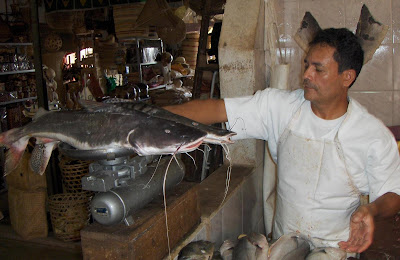 Santarém is famous for its fish. Hardly anyones leaves the city for Belém or Manaus without taking an ice-chest full of fish to family and friends. One of the favorite fish is catfish, the ones seen in the image. These two beauties ended up at our place for eating, and also for taking to Belém the next time Áurea visits her parents and our son, Daniel. Our friend, Dona Joana, did the honors of preparing the fish.
Santarém is famous for its fish. Hardly anyones leaves the city for Belém or Manaus without taking an ice-chest full of fish to family and friends. One of the favorite fish is catfish, the ones seen in the image. These two beauties ended up at our place for eating, and also for taking to Belém the next time Áurea visits her parents and our son, Daniel. Our friend, Dona Joana, did the honors of preparing the fish.
Sunday, June 29, 2008
Old fence post
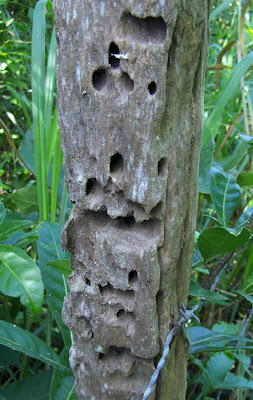 If only an old fence post could talk, think of the history it could tell. The fence that includes this old soldier is relatively new, put up by my neighbor at Bosque Santa Lucia to keep his cows and goats at home. But we can be sure that the post, itself, is several decades old. It's fought other wars in the past. The wood that remains is hard as nails, but it was probably much larger when a young soldier. Termites always start with the softest wood and then work up. I'm willing to bet that the fence post will be around for a few more decades. I know people who love to make charcoal from old fence material. It's said to be the best.
If only an old fence post could talk, think of the history it could tell. The fence that includes this old soldier is relatively new, put up by my neighbor at Bosque Santa Lucia to keep his cows and goats at home. But we can be sure that the post, itself, is several decades old. It's fought other wars in the past. The wood that remains is hard as nails, but it was probably much larger when a young soldier. Termites always start with the softest wood and then work up. I'm willing to bet that the fence post will be around for a few more decades. I know people who love to make charcoal from old fence material. It's said to be the best.
Saturday, June 28, 2008
Spider on stage
 This spider is normally quite cryptic, almost invisible on the trunk of trees. At this photographic session it was highlighted because of the blotch of fungus in the background.
This spider is normally quite cryptic, almost invisible on the trunk of trees. At this photographic session it was highlighted because of the blotch of fungus in the background.
Orchid, back to the tree
 I showed this orchid in bloom some days ago, after which I discovered from Cláudio Serique that it would develop better if put on the side of a tree, rather than in a vase. Come to think of it, I never saw one of these rat-tailed orchids in a vase. Always on the trunk of a tree. I tied this one onto a rosewood tree close to the reception center. It seemed to have like the charcoal I had in the vase, so I left the pieces on the root system.
I showed this orchid in bloom some days ago, after which I discovered from Cláudio Serique that it would develop better if put on the side of a tree, rather than in a vase. Come to think of it, I never saw one of these rat-tailed orchids in a vase. Always on the trunk of a tree. I tied this one onto a rosewood tree close to the reception center. It seemed to have like the charcoal I had in the vase, so I left the pieces on the root system.
Tails of leaves, continued
 I discovered this little tree loaded with new leaves only meters from the one shown on the previous post. It has the look of having been broken off at the top.
I discovered this little tree loaded with new leaves only meters from the one shown on the previous post. It has the look of having been broken off at the top.
Tails of leaves
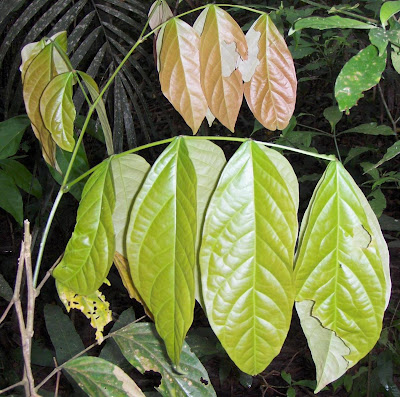 I've heard that trees will produce new leaves in different colors to fake off leaf cutting insects, thus giving the leaves a chance to get tough and mature. These must be rather appetizing because they're getting eaten up anyway. Maybe the green is showing!
I've heard that trees will produce new leaves in different colors to fake off leaf cutting insects, thus giving the leaves a chance to get tough and mature. These must be rather appetizing because they're getting eaten up anyway. Maybe the green is showing!
Tento, continued
 If I hadn't been looking up into the tento tree when we were removing leaf samples, I wouldn't have seen that it was in bloom. The flowers were almost up in the crown of the tree, so I got the best zoom shot I could with a simple digital camera. The image won't win any prizes, but it's good for the records of comparing trees. By the way, the genus of the tento tree is Ormosia. The family is Fabaceae. Sorry, I don't have the species.
If I hadn't been looking up into the tento tree when we were removing leaf samples, I wouldn't have seen that it was in bloom. The flowers were almost up in the crown of the tree, so I got the best zoom shot I could with a simple digital camera. The image won't win any prizes, but it's good for the records of comparing trees. By the way, the genus of the tento tree is Ormosia. The family is Fabaceae. Sorry, I don't have the species.
Tento
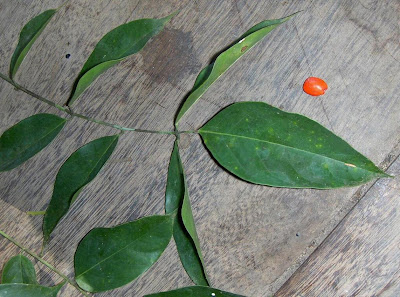 On placing this image, I need to make it clear that I'm not a forester. And no, I'm not a botanist. I'm only interested in these things and there are times when I get into pissing contests with others who are likewise not professionally qualified to identify certain trees. Having samples of leaves and seeds make a case. The hard, red seed in the image is called tento. It's used by everyone in the arts and crafts industry as a favorite for making necklaces, bracelets and other jewelry and decorations. But ... biodiversity being what it is here in the Amazon, there are many different kinds of tento trees. Some produce red seeds in different sizes and formats. Some produce black and red seeds. And so it goes. I'll keep these leaves and seeds around to compare with others, as I find them.
On placing this image, I need to make it clear that I'm not a forester. And no, I'm not a botanist. I'm only interested in these things and there are times when I get into pissing contests with others who are likewise not professionally qualified to identify certain trees. Having samples of leaves and seeds make a case. The hard, red seed in the image is called tento. It's used by everyone in the arts and crafts industry as a favorite for making necklaces, bracelets and other jewelry and decorations. But ... biodiversity being what it is here in the Amazon, there are many different kinds of tento trees. Some produce red seeds in different sizes and formats. Some produce black and red seeds. And so it goes. I'll keep these leaves and seeds around to compare with others, as I find them.
Friday, June 27, 2008
Fungi on manioc press
 The two vertical pieces of wood are what remain of an old manioc press used by the former residents of the farm where Bosque Santa Lucia is located today. My wife and I bought the property in 1981, and I remember that our caretaker continued to used the press and other infrastructure for at least three years. So, I guess it's been about 25 years since the press was last used. The tree to the right, a pau mulato (Calycophyllum spruceanum), has grown up since that time. We can rest assured that those two pieces of wood are of some noble wood, maybe cumuru (Dipteryx odorate). Otherwise the termites would have eaten them up completely. No matter how noble we might be, fungi will get us us sooner or later.
The two vertical pieces of wood are what remain of an old manioc press used by the former residents of the farm where Bosque Santa Lucia is located today. My wife and I bought the property in 1981, and I remember that our caretaker continued to used the press and other infrastructure for at least three years. So, I guess it's been about 25 years since the press was last used. The tree to the right, a pau mulato (Calycophyllum spruceanum), has grown up since that time. We can rest assured that those two pieces of wood are of some noble wood, maybe cumuru (Dipteryx odorate). Otherwise the termites would have eaten them up completely. No matter how noble we might be, fungi will get us us sooner or later.
Guaraná
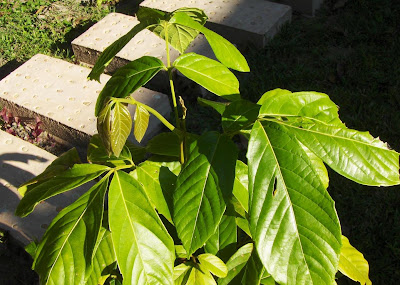 At last this young guaraná plant (Paulinia cupana) is moving forward. I planted it from a seed taken from the first tree planted many years ago around the old roundhouse. In reality, the older one is more of a vine than a tree. When planted in the shade of other trees, guaraná grows up as a vine. When planted out in the open, it becomes a tree. Well, sort of! We'll see what this one becomes.
At last this young guaraná plant (Paulinia cupana) is moving forward. I planted it from a seed taken from the first tree planted many years ago around the old roundhouse. In reality, the older one is more of a vine than a tree. When planted in the shade of other trees, guaraná grows up as a vine. When planted out in the open, it becomes a tree. Well, sort of! We'll see what this one becomes.
Thursday, June 26, 2008
Vulture's herb
 The erva de urubu plants are at their best now. Local informants report that the juice of this berry is good for getting rid of skin fungus, that type that leaves white blotches on our epidermis.
The erva de urubu plants are at their best now. Local informants report that the juice of this berry is good for getting rid of skin fungus, that type that leaves white blotches on our epidermis.
Fungi 2008, continued
 This dead tree was loaded with white fungi from the top to the bottom. I've never seen a whiter white.
This dead tree was loaded with white fungi from the top to the bottom. I've never seen a whiter white.
Wednesday, June 25, 2008
The Thief at the End of the World
 I'm delighted to have received Joe Jackson's book, The Thief at the End of the World. I'm even more pleased to have received it from the author, himself. Joe spent one morning with me at Bosque Santa Lucia in October, 2005, while researching the life of Henry Wickham, the alias "thief", who made off with the rubber tree seeds. Wickham immigrated to the Amazon from England in 1871, and farmed at piquía-tuba, which is at the top of the hill on the way to the Bosque. It can't be more than 3-4 kilometers away, as the vulture flies. Knowing the place and some of the history of rubber, I savored every last word in Joe's book. Image: latex forming from a cut on a rubber tree (Hevea brasiliensis) at Bosque Santa Lúcia.
I'm delighted to have received Joe Jackson's book, The Thief at the End of the World. I'm even more pleased to have received it from the author, himself. Joe spent one morning with me at Bosque Santa Lucia in October, 2005, while researching the life of Henry Wickham, the alias "thief", who made off with the rubber tree seeds. Wickham immigrated to the Amazon from England in 1871, and farmed at piquía-tuba, which is at the top of the hill on the way to the Bosque. It can't be more than 3-4 kilometers away, as the vulture flies. Knowing the place and some of the history of rubber, I savored every last word in Joe's book. Image: latex forming from a cut on a rubber tree (Hevea brasiliensis) at Bosque Santa Lúcia.
Ruth Cardoso, in memoriam
 Ruth Cardoso, ex-president Henrique Cardoso's wife, died at their apartment in São Paulo this morning. I had the pleasure of accompanying her on a visit to the Museum for the Preservation of Indigenous Arts in Alter do Chão back in 1997. Indigenous art isn't exactly my cup of tea, but David Richardson, owner of the museum, was away and asked me the favor. It turned out to be an easy task because Ruth Cardoso didn't need a lot of explanations. She was well versed in the subject matter. I made mention of the visit in my book, Santarém - Riverboat Town.
Ruth Cardoso, ex-president Henrique Cardoso's wife, died at their apartment in São Paulo this morning. I had the pleasure of accompanying her on a visit to the Museum for the Preservation of Indigenous Arts in Alter do Chão back in 1997. Indigenous art isn't exactly my cup of tea, but David Richardson, owner of the museum, was away and asked me the favor. It turned out to be an easy task because Ruth Cardoso didn't need a lot of explanations. She was well versed in the subject matter. I made mention of the visit in my book, Santarém - Riverboat Town."On occasion, visitors ask where they can purchase gold nuggets, or gold jewelry. As a matter of fact, Santarém boasts several outstanding goldsmiths, but most of them work on a custom-made basis for their clients. Thus, it is not easy to find a shop with any great selection of pieces from which to purchase on the spot. The closest is Joalheria João Sena, located in downtown Santarém on Travessa 15 de Agosto. An item of special interest is a flat gold pendant representing the legendary Muiraquitã, a frog amulet. João Sena, one of the most skilled goldsmiths in Santarém, makes diverse gold-crafted pendants portraying both Tapajônica and Marajoara designs. Ouro is ouro and the Brazilian standard for jewelry is 18 karat, so do not be surprised if prices reflect these little details. It is noteworthy to mention that when the Primeira Dama (first lady) of
Hairy cats
 Speaking of caterpillars, last week one of these little devils caused a great deal of pain to Gustavo, a medical student visiting Fundaçao Esperança. He and Marina, a visiting professor at the university, had just started their walking tour at Bosque Santa Lúcia when he remarked that something had stung his right thumb. Indeed his thumb was red and rapidly swelling up. Then I noticed the caterpillar on his shirt. I thought for a moment that we would need to return to Santarém for treatment, but an application of topical anesthetic and a great deal of "biting the bullet" on the part of Gustavo resolved the problem.
Speaking of caterpillars, last week one of these little devils caused a great deal of pain to Gustavo, a medical student visiting Fundaçao Esperança. He and Marina, a visiting professor at the university, had just started their walking tour at Bosque Santa Lúcia when he remarked that something had stung his right thumb. Indeed his thumb was red and rapidly swelling up. Then I noticed the caterpillar on his shirt. I thought for a moment that we would need to return to Santarém for treatment, but an application of topical anesthetic and a great deal of "biting the bullet" on the part of Gustavo resolved the problem.
Small caterpillar
 The day that I returned that wad of giant caterpillars to the woods, I nearly stepped on this small one. It's less than an inch long. Click on the image to get a better view of it. Can you tell which end is the head and which is the tail? I've never seen this one before, but something tells me that it's capable to producing a lot of pain, if touched.
The day that I returned that wad of giant caterpillars to the woods, I nearly stepped on this small one. It's less than an inch long. Click on the image to get a better view of it. Can you tell which end is the head and which is the tail? I've never seen this one before, but something tells me that it's capable to producing a lot of pain, if touched.
Tuesday, June 24, 2008
Colors of ginja
 In the middle of many plants making up the ornamental fence at the entranceway is ginja, a fruit tree in genus of Eugenia. It produces a delicious red fruit, which is one of my favorite. These plants come from seeds taken from an old ginja tree, which used to be in our backyard here in the city.
In the middle of many plants making up the ornamental fence at the entranceway is ginja, a fruit tree in genus of Eugenia. It produces a delicious red fruit, which is one of my favorite. These plants come from seeds taken from an old ginja tree, which used to be in our backyard here in the city.
Roadside flower
 Out of nowhere, beautiful flowers make their appearance on the side of the dirt road going into Bosque Santa Lucia. I don't know the name of this one; you don't know the name of it; I dare say that nobody knows the name of it, but that doesn't take the beauty away from the flower. Such is tropical biodiversity.
Out of nowhere, beautiful flowers make their appearance on the side of the dirt road going into Bosque Santa Lucia. I don't know the name of this one; you don't know the name of it; I dare say that nobody knows the name of it, but that doesn't take the beauty away from the flower. Such is tropical biodiversity.
Monday, June 23, 2008
Marimari da Terra Firme blooming
 Another year has flown by and the marimari da terra firme trees (Senna multijuga) are blooming again. It doesn't get to be a big tree, but its one well endowed with beautiful yellow flowers.
Another year has flown by and the marimari da terra firme trees (Senna multijuga) are blooming again. It doesn't get to be a big tree, but its one well endowed with beautiful yellow flowers.
Henry Ford in the jungle
 On my trip to Belterra a few days ago, I made a stop to collect some Brazilian cedar (Cedrela odorata) seeds from that very high tree in the middle of the image, the one without leaves. It was loaded with pods, but none had fallen. I thought the tree might be dead, since our cedar trees at Bosque Santa Lucia have been in full dress since the rainy season started. A local employee came out of a neighboring building to say hello. He had visited our Bosque a few years ago as part of a course he was taking in Santarem. He told me that the tree was very much alive, but the seed pods hadn't started to fall. The neat white house in the background is referred to as "House Number one." It was build exclusively for Henry Ford, who had planned a visit to his rubber tree plantations in the Amazon. Unfortunately, the trip was canceled because of the death of his son and the industrial magnate never scheduled another visit. As a matter of fact, Henry Ford never once set foot in the Amazon.
On my trip to Belterra a few days ago, I made a stop to collect some Brazilian cedar (Cedrela odorata) seeds from that very high tree in the middle of the image, the one without leaves. It was loaded with pods, but none had fallen. I thought the tree might be dead, since our cedar trees at Bosque Santa Lucia have been in full dress since the rainy season started. A local employee came out of a neighboring building to say hello. He had visited our Bosque a few years ago as part of a course he was taking in Santarem. He told me that the tree was very much alive, but the seed pods hadn't started to fall. The neat white house in the background is referred to as "House Number one." It was build exclusively for Henry Ford, who had planned a visit to his rubber tree plantations in the Amazon. Unfortunately, the trip was canceled because of the death of his son and the industrial magnate never scheduled another visit. As a matter of fact, Henry Ford never once set foot in the Amazon.
Sunday, June 22, 2008
Santarém - City of the Rivers
 Tell me, what's a river without fish? And is there a fish more famous than the tucunaré, alias peacock bass? Not in the Amazon .. and we have lots of different species of fish. A display of replicas of Amazonian animals on the newly inaugurated orla is attracting a lot of attention, especially with the kids. On a walk there late this afternoon, I couldn't believe the number of parents taking pictures of their children. I never saw so many digital cameras in my life! Good sign, I must say.
Tell me, what's a river without fish? And is there a fish more famous than the tucunaré, alias peacock bass? Not in the Amazon .. and we have lots of different species of fish. A display of replicas of Amazonian animals on the newly inaugurated orla is attracting a lot of attention, especially with the kids. On a walk there late this afternoon, I couldn't believe the number of parents taking pictures of their children. I never saw so many digital cameras in my life! Good sign, I must say.
Santarém - City of the Rivers
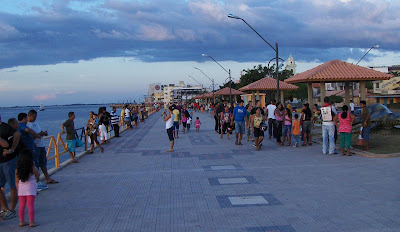 It's normal for the local government to inaugurate public works on the birthday of the city and this 347th is no different. This present has been in the making for some time and an expensive one. It's an additional 500 meters of waterfront, which makes for at least one kilometer of shore protection from the fast moving Tapajós River and a fantastic walkway overlooking the rivers and the city. I hope that another 500 meters will be initiated soon because this Orla facilitates public recreation and access to one of the most beautiful river fronts in the world.
It's normal for the local government to inaugurate public works on the birthday of the city and this 347th is no different. This present has been in the making for some time and an expensive one. It's an additional 500 meters of waterfront, which makes for at least one kilometer of shore protection from the fast moving Tapajós River and a fantastic walkway overlooking the rivers and the city. I hope that another 500 meters will be initiated soon because this Orla facilitates public recreation and access to one of the most beautiful river fronts in the world.
Andiroba oil
 The better known byproduct of the andiroba seeds is óleo de andiroba, or andiroba oil. The medicinal use of this oil is widespread throughout the Amazon and most of Brazil. Obviously, it was first discovered by the Indians, long before the Europeans arrived on the scene. The small bottle shown in the image is one I keep at Bosque Santa Lucia for visitors, when they forget their insect repellent. Most people don't like the smell of the oil, but it does the job. It's also used to rehydrate the skin and stop itching. I need to restock my supply.
The better known byproduct of the andiroba seeds is óleo de andiroba, or andiroba oil. The medicinal use of this oil is widespread throughout the Amazon and most of Brazil. Obviously, it was first discovered by the Indians, long before the Europeans arrived on the scene. The small bottle shown in the image is one I keep at Bosque Santa Lucia for visitors, when they forget their insect repellent. Most people don't like the smell of the oil, but it does the job. It's also used to rehydrate the skin and stop itching. I need to restock my supply.
Andiroba seeds
 I picked up these andiroba seeds (Carapa guianensis) in Belterra a few days ago and they've since been planted at Bosque Santa Lucia. As you can see, they're really very large seeds. If planted right away, they germination rate is very good. There are a few of these trees at Bosque Santa Lucia, one already producing seeds. The family is Meliaceae, the same as mahogany.
I picked up these andiroba seeds (Carapa guianensis) in Belterra a few days ago and they've since been planted at Bosque Santa Lucia. As you can see, they're really very large seeds. If planted right away, they germination rate is very good. There are a few of these trees at Bosque Santa Lucia, one already producing seeds. The family is Meliaceae, the same as mahogany.
Santarém - the Rivers
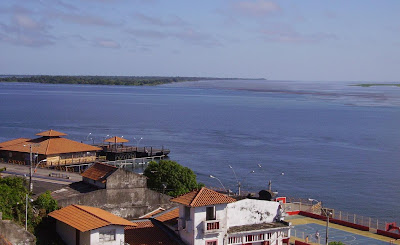 Now another image of Santarém and the rivers, the Amazon and the Tapajós. That's the Tapajós River flowing past the city and that's the Amazon far out there where you see a difference of color. They're probably not much difference than back in 1542, when the first European, Francisco Orellana, made his way down the Amazon returning to Spain. Visitors often comment on the lack of traffic on the rivers. As you can see, there's not one one ship, not one barge, not one riverboat out there on two of the largest rivers in the world.
Now another image of Santarém and the rivers, the Amazon and the Tapajós. That's the Tapajós River flowing past the city and that's the Amazon far out there where you see a difference of color. They're probably not much difference than back in 1542, when the first European, Francisco Orellana, made his way down the Amazon returning to Spain. Visitors often comment on the lack of traffic on the rivers. As you can see, there's not one one ship, not one barge, not one riverboat out there on two of the largest rivers in the world.
Saturday, June 21, 2008
Santarém - Riverboat Town
 Another view of Santarém from the Cargill buoy on the western side of town. Blue skies, blue waters and a distant view of the city, so appropriately called the "Pearl of the Tapajós". The city is celebrating its 347th birthday this week.
Another view of Santarém from the Cargill buoy on the western side of town. Blue skies, blue waters and a distant view of the city, so appropriately called the "Pearl of the Tapajós". The city is celebrating its 347th birthday this week.
Santarém - Riverboat Town
 The ship loading up with soybeans didn't need a lot of line for tying up to the Cargill pier because the grain elevators are built far out into the waters of the Tapajós River. Ships simply nudge up against the elevator pier to receive giant spouts, which fill up a ship in short order.
The ship loading up with soybeans didn't need a lot of line for tying up to the Cargill pier because the grain elevators are built far out into the waters of the Tapajós River. Ships simply nudge up against the elevator pier to receive giant spouts, which fill up a ship in short order.
Anniversary of Santarém
 Maybe I'm presenting a different view of Santarém on its 347th anniversary. It's one from the bow of a ship that was loading up with soybeans at the Cargill grain pier. The scene reminded me that most people seeing Santarém for the first time in the past saw it from the decks of a riverboat. This picture presents Santarém from the Tapajós River, as noted by the blue of the water. When I arrived in 1979, Santarém had a population of approximately 94,000 people. Today, the city population is around 266,000.
Maybe I'm presenting a different view of Santarém on its 347th anniversary. It's one from the bow of a ship that was loading up with soybeans at the Cargill grain pier. The scene reminded me that most people seeing Santarém for the first time in the past saw it from the decks of a riverboat. This picture presents Santarém from the Tapajós River, as noted by the blue of the water. When I arrived in 1979, Santarém had a population of approximately 94,000 people. Today, the city population is around 266,000.
Friday, June 20, 2008
Orchid, unidentified
 Another orchid in bloom. I've forgotten the name of this one, but I call it "rat-tailed orchid" for the lack of a better name. My friend, Claudio Serique and his wife, Bernadette, will help me out the next time they look at my blog.
Another orchid in bloom. I've forgotten the name of this one, but I call it "rat-tailed orchid" for the lack of a better name. My friend, Claudio Serique and his wife, Bernadette, will help me out the next time they look at my blog.
Orchid, Brassia caudata, continued
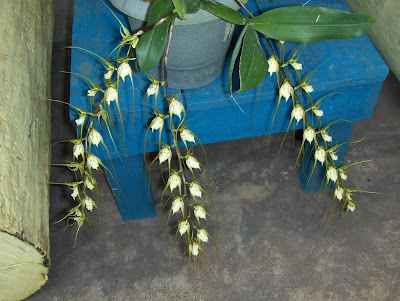 Another view of the Brassia caudata orchid in bloom showing all three stems. I've had the orchid for some years, having collected it at the Tapajós National Forest on an Orchid Society trip. All my orchids were originally placed in trees at Bosque Santa Lucia but I lost several and they didn't adapt very well to the dust during summer months. Eventually, I moved them under the edges of the porch at the reception center where I could take better care of them. I don't have many orchids and I must admit that I don't know much about them. I have friends in Santarem, who are professional at the art of collecting and taking care of orchids. In upcoming posts, I'll talk more about these folks and their plants.
Another view of the Brassia caudata orchid in bloom showing all three stems. I've had the orchid for some years, having collected it at the Tapajós National Forest on an Orchid Society trip. All my orchids were originally placed in trees at Bosque Santa Lucia but I lost several and they didn't adapt very well to the dust during summer months. Eventually, I moved them under the edges of the porch at the reception center where I could take better care of them. I don't have many orchids and I must admit that I don't know much about them. I have friends in Santarem, who are professional at the art of collecting and taking care of orchids. In upcoming posts, I'll talk more about these folks and their plants.
Orchid, Brassia caudata
 Brassia caudata is blooming again and, as usual, it quite beautiful. Come to think of it, I've never seen an orchid that's not beautiful. Some of them leave the viewer stunned beyond belief.
Brassia caudata is blooming again and, as usual, it quite beautiful. Come to think of it, I've never seen an orchid that's not beautiful. Some of them leave the viewer stunned beyond belief.
Thursday, June 19, 2008
Cupuaçu seedling
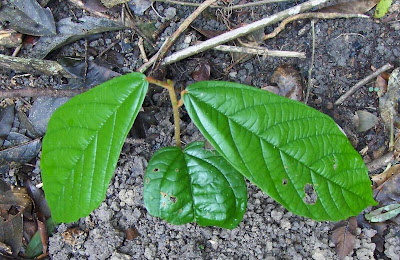 Cupuaçu seeds (Theobroma grandiflorum) germinate real easy and it's always a pleasure putting them in the ground. Cupuaçu is probably the most expensive fruit in the Amazon, whether bought as a fruit, or in pulp form. As the genus name implies, this tree is a cousin of the chocolate tree, or cacao. The fruit, itself, doesn't look like cacao, but the leaves are similar. Seeds of the cupuaçu can also be used to make chocolate. I've not seen it, but evidently it's a white chocolate. Over the years I've discovered that some foreigners like foods made of cupuaçu and others can't stand it. I've never met a Brazilian who didn't appreciate the fruit!
Cupuaçu seeds (Theobroma grandiflorum) germinate real easy and it's always a pleasure putting them in the ground. Cupuaçu is probably the most expensive fruit in the Amazon, whether bought as a fruit, or in pulp form. As the genus name implies, this tree is a cousin of the chocolate tree, or cacao. The fruit, itself, doesn't look like cacao, but the leaves are similar. Seeds of the cupuaçu can also be used to make chocolate. I've not seen it, but evidently it's a white chocolate. Over the years I've discovered that some foreigners like foods made of cupuaçu and others can't stand it. I've never met a Brazilian who didn't appreciate the fruit!
Tortoise shell
 My caretaker, Cleuson, brought me this tortoise shell recently. He said that he had found it in the brush next to the road. Then came the rest of the sad story. There were ten of them! Someone had killed ten young tortoises, scrapped out the edible parts and then tossed the remains on the side of the road. They would have gone unnoticed but for the smell. As I've said more than once, wild animals don't have a chance of survival around mankind. And mankind seems to be everywhere these days.
My caretaker, Cleuson, brought me this tortoise shell recently. He said that he had found it in the brush next to the road. Then came the rest of the sad story. There were ten of them! Someone had killed ten young tortoises, scrapped out the edible parts and then tossed the remains on the side of the road. They would have gone unnoticed but for the smell. As I've said more than once, wild animals don't have a chance of survival around mankind. And mankind seems to be everywhere these days.
Wednesday, June 18, 2008
Army ants, continued
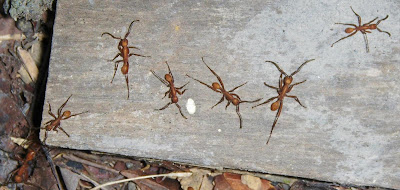 After crossing the newly constructed sidewalk, the long line of army ants moved across a relatively clean board, which provided even better contrast. Notice the long legs of these ants. I'm told that they are totally blind, moving about through chemical tracing.
After crossing the newly constructed sidewalk, the long line of army ants moved across a relatively clean board, which provided even better contrast. Notice the long legs of these ants. I'm told that they are totally blind, moving about through chemical tracing.
Army ants, continued
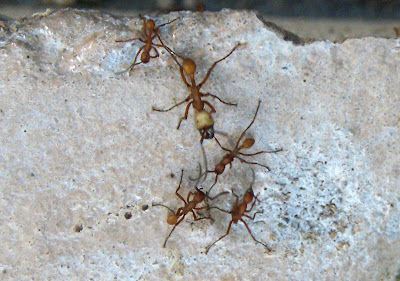 I run into legions of army ants every day I'm at Bosque Santa Lucia, but I've not taken many good photographs of our nomadic friends. This week I caught a long moving line of them crossing a newly constructed sidewalk, which makes for greater contrast. That guy with the big head must be a guard. He's obviously looking at me!
I run into legions of army ants every day I'm at Bosque Santa Lucia, but I've not taken many good photographs of our nomadic friends. This week I caught a long moving line of them crossing a newly constructed sidewalk, which makes for greater contrast. That guy with the big head must be a guard. He's obviously looking at me!
Tuesday, June 17, 2008
Caterpillar food, continued
 And here are a few of more than 30 individuals found in the caterpillar "nest". What I did was to cut the frond from the palm and then open it up completely on the sink of the porch. In little time the caterpillars started moving about, but they didn't leave the frond. After getting some pictures, I left the frond at the edge of the woods next to the reception center. Later I checked on our friends to discover that some were busy creating a new web enclosure. I thought to myself that I have become more ecological minded that I was in the past. I remember 2-3 years ago another palm had been invaded by the same type of caterpillars and I had reacted very irrationally. My immediate reaction was to kill the critters, which I did by spraying them with a heavy dose of kerosene and water. After all, they were eating one of my favorite palms. What I didn't expect was that I would kill the palm too. A few days later the palm tree gave sign of taking its last breath. The worse part was that it was my only dendê palm (Elaeis guineensis) and it was doing exceptionally well. The caterpillars had eaten most of the leaves, but that's not the end of the world for palms. They jump back up by growing new fronds. By doing something stupid, I killed off a whole bunch of future butterflies and also one of my favorite palms.
And here are a few of more than 30 individuals found in the caterpillar "nest". What I did was to cut the frond from the palm and then open it up completely on the sink of the porch. In little time the caterpillars started moving about, but they didn't leave the frond. After getting some pictures, I left the frond at the edge of the woods next to the reception center. Later I checked on our friends to discover that some were busy creating a new web enclosure. I thought to myself that I have become more ecological minded that I was in the past. I remember 2-3 years ago another palm had been invaded by the same type of caterpillars and I had reacted very irrationally. My immediate reaction was to kill the critters, which I did by spraying them with a heavy dose of kerosene and water. After all, they were eating one of my favorite palms. What I didn't expect was that I would kill the palm too. A few days later the palm tree gave sign of taking its last breath. The worse part was that it was my only dendê palm (Elaeis guineensis) and it was doing exceptionally well. The caterpillars had eaten most of the leaves, but that's not the end of the world for palms. They jump back up by growing new fronds. By doing something stupid, I killed off a whole bunch of future butterflies and also one of my favorite palms.
Caterpillar food, continued
 Smart critters, those caterpillars. Notice that they didn't eat the leaves of the frond where they have built a nest, if that's the right word. What looks like a bird's nest is full of big caterpillars all bunched up together. As pictured, the weight is great enough that the whole frond is drooping to the ground. There are more than 30 caterpillars inside! The web was closed when I found it. I opened the top to get a view inside. Next image will be of the caterpillars, themselves.
Smart critters, those caterpillars. Notice that they didn't eat the leaves of the frond where they have built a nest, if that's the right word. What looks like a bird's nest is full of big caterpillars all bunched up together. As pictured, the weight is great enough that the whole frond is drooping to the ground. There are more than 30 caterpillars inside! The web was closed when I found it. I opened the top to get a view inside. Next image will be of the caterpillars, themselves.
Caterpillar food
Sunday, June 15, 2008
Portals, continued
 Here's another image of the tachi cauaçu tree (Tripolaris sp.), host of these tachi ants seen in the image. I take it that this piece of natural art is one of the former portals for the ants, which make their home inside the hollow part of tree. I also speculate that the original entranceway for the ants was sealed off by the tree in some chemical reaction to the coming and going of the guests. Strictly speculation on my part.
Here's another image of the tachi cauaçu tree (Tripolaris sp.), host of these tachi ants seen in the image. I take it that this piece of natural art is one of the former portals for the ants, which make their home inside the hollow part of tree. I also speculate that the original entranceway for the ants was sealed off by the tree in some chemical reaction to the coming and going of the guests. Strictly speculation on my part.
Tucumã palm
Saturday, June 14, 2008
Bracket Fungi
 It's always neat to have visitors at Bosque Santa Lucia because they see the forest with fresh eyes and they often see what I don't. I had walked right under this dead mucajá palm (Acrocomia aculeata) today without noticing what was up above. I hadn't even noticed that it was dead. Eric and Jennifer, from Denver, called me back to have a look. Bracket fungi at their best.
It's always neat to have visitors at Bosque Santa Lucia because they see the forest with fresh eyes and they often see what I don't. I had walked right under this dead mucajá palm (Acrocomia aculeata) today without noticing what was up above. I hadn't even noticed that it was dead. Eric and Jennifer, from Denver, called me back to have a look. Bracket fungi at their best.
Friday, June 13, 2008
Fashion shows, continued
 Like it's not every day that I visit Dona Dica's atelier, but she always remembers my name. Nearing 87, she's got a memory that puts most of us to shame. The visit that I described in the two previous posts went on nearly two hours! I was pleased that I took my camera for some historical photos, but it would have been better had the whole event been filmed with sound. Dona Dica told us that she's traveling to Belém, nearly an hour by plane, in the next few days to receive an award that's equivalent to "Professional Woman of Year for the State of Pará". She's also preparing for a show at the Opera House, where nine of her creations will be presented to the fashion world. And the show goes on. Thanks spending time with us, Dona Dica Frazão.
Like it's not every day that I visit Dona Dica's atelier, but she always remembers my name. Nearing 87, she's got a memory that puts most of us to shame. The visit that I described in the two previous posts went on nearly two hours! I was pleased that I took my camera for some historical photos, but it would have been better had the whole event been filmed with sound. Dona Dica told us that she's traveling to Belém, nearly an hour by plane, in the next few days to receive an award that's equivalent to "Professional Woman of Year for the State of Pará". She's also preparing for a show at the Opera House, where nine of her creations will be presented to the fashion world. And the show goes on. Thanks spending time with us, Dona Dica Frazão.
Fashion shows, continued
 While Dona Dica was showing Marina several dresses made of natural fibers from the jungle of the upper Tapajós River, I headed off to her backyard to see the source of feathers for her works of art. These two handsome geese met me at the door and put on a show themselves. The use of feathers for the fashion world doesn't seem to be as popular as it was in the past, but when used, Dona Dica doesn't need to kill off those beautiful birds flying around the jungle forest. Our friends in the above image make their contribution in favor of their jungle cousins.
While Dona Dica was showing Marina several dresses made of natural fibers from the jungle of the upper Tapajós River, I headed off to her backyard to see the source of feathers for her works of art. These two handsome geese met me at the door and put on a show themselves. The use of feathers for the fashion world doesn't seem to be as popular as it was in the past, but when used, Dona Dica doesn't need to kill off those beautiful birds flying around the jungle forest. Our friends in the above image make their contribution in favor of their jungle cousins.
Fashion Shows from the Jungle

I always recommend that visitors stop by to see my friend, Dona Dica Frazão, at Rua Floriano Peixoto, 281. Her Tapajônica style dresses, tunics, purses, fans, table clothes, towels, flowers and other fineries for women are all made of natural bark and root/vine fibers gathered by Indians on the upper
Thursday, June 12, 2008
Poisonous plant
 The plant in the attached image is beautiful, but a poisonous one. It's called Mata vaca, which translates into "kill the cow". According to local lore, a few of these leaves will kill a cow deader than you know what. Ranchers have nightmares visualizing this one in their pasture lands. The family is Rubiaceae and the genus Psychotria. We have lots of these plants at Bosque Santa Lucia, but no cattle. Smile.
The plant in the attached image is beautiful, but a poisonous one. It's called Mata vaca, which translates into "kill the cow". According to local lore, a few of these leaves will kill a cow deader than you know what. Ranchers have nightmares visualizing this one in their pasture lands. The family is Rubiaceae and the genus Psychotria. We have lots of these plants at Bosque Santa Lucia, but no cattle. Smile.
Wednesday, June 11, 2008
Flower
 I wish I knew the name of this plant, but nobody seems to know. That is fairly standard for many plants and trees. They're appreciated, but nobody knows the name of them. This one was given to my by Dona Inez, a retired teacher in the community of Poço Branco. Every now and then it produces a single flower, which is so beautiful, it stuns me looking at it.
I wish I knew the name of this plant, but nobody seems to know. That is fairly standard for many plants and trees. They're appreciated, but nobody knows the name of them. This one was given to my by Dona Inez, a retired teacher in the community of Poço Branco. Every now and then it produces a single flower, which is so beautiful, it stuns me looking at it.
Tuesday, June 10, 2008
Falling bark
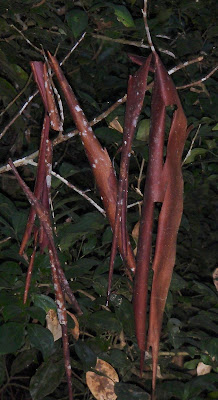 One of my favorite trees at Bosque Santa Luica is pau mulato (Calycophyllum spruceanum). It's one of the ironwood trees, which makes it a favorite for making charcoal. I'm not in the business of making charcoal, but I remember many years ago when I had a caretaker, who nearly cut all of these trees for that reason. I guess he needed some extra pocket change and it was the thing to do back in those days. The bark of this tree peels off at least once a year, leaving it as slick as you know what. Image: pieces of bark caught up in the brush below.
One of my favorite trees at Bosque Santa Luica is pau mulato (Calycophyllum spruceanum). It's one of the ironwood trees, which makes it a favorite for making charcoal. I'm not in the business of making charcoal, but I remember many years ago when I had a caretaker, who nearly cut all of these trees for that reason. I guess he needed some extra pocket change and it was the thing to do back in those days. The bark of this tree peels off at least once a year, leaving it as slick as you know what. Image: pieces of bark caught up in the brush below.



